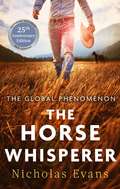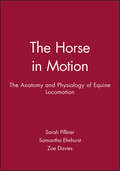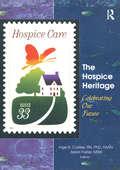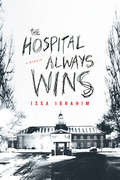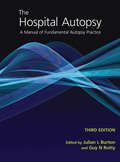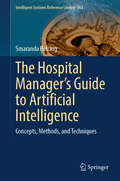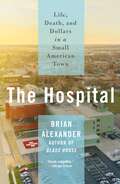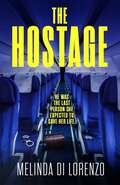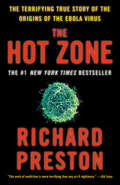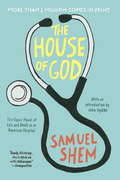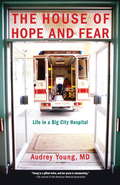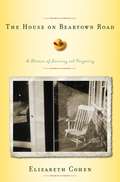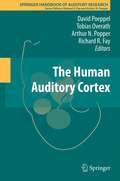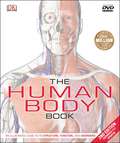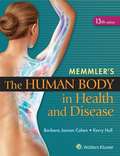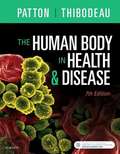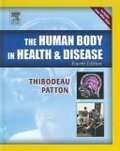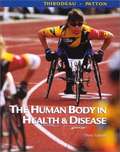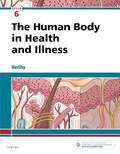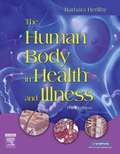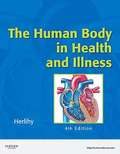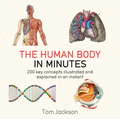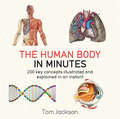- Table View
- List View
The Horse Whisperer: The 25th anniversary edition of a classic novel that was made into a beloved film (Pearson English Active Readers Ser.)
by Nicholas EvansThe phenomenal number one bestseller, which sold over twenty million copies and was made into a classic film starring Robert Redford and Scarlett Johansson. This stunning 25th anniversary edition features exclusive new content from Nicholas Evans.'A love story, a gripping adventure and an emotionally charged tale of redemption and human strength' Cosmopolitan'Brilliance pervades this five-handkerchief weepie' The Times'Wild horses couldn't drag me from this . . . a tear-jerking page-turner' Daily Mail____________________When Grace Maclean and her beloved horse, Pilgrim, are hit by a truck one snow-covered morning, their destinies become inextricably bound to one another. Though both manage to survive the tragedy, the impact on their lives is devastating; both horse and girl are traumatised and profoundly changed. Beside herself with worry, Grace's mother, Annie Macean, hears about a man called Tom Brooker, a 'whisperer' said to possess the gift of healing troubled horses. He is her last hope and she decides to abandon her life in upstate New York, setting off across the continent with Grace and Pilgrim to find him. This journey, under the sweeping Montana sky, will change all their lives for ever . . .____________________What everyone's saying about The Horse Whisperer:'A book that couldn't have been written any better. Nicholas Evans spins a heart wrenching epic love story . . . Buy it, borrow it or steal it. But don't miss this gem for anything' Five stars, Goodreads reviewer'A beautiful story, beautifully told. If you've seen the movie, do yourself a favour and read the book. The reading experience will make the movie version even better' Five stars, Goodreads reviewer'Easily in my top 5 books I have ever read . . . Some parts of the story were devastating and some parts were magical. If you aren't scared to feel all of the feelings, read this. Be prepared to have your heart ripped out' Five stars, Goodreads reviewer'This has to be one of the best books I have ever read and it had me hooked from the first page . . . If you have seen the film then I beg you to read this book because the director truly hasn't done this amazing story justice!' Five stars, Amazon reviewer
The Horse in Motion: The Anatomy and Physiology of Equine Locomotion
by Sarah Pilliner Zoe Davies Samantha ElmhurstWe all want our horses to be able to perform to the best of their ability and we know that an effective training regime has many facets. The horse must be worked correctly, fed a balanced ration, mentally and physically healthy and well looked after. This book examines a further aspect of the horse's performance: it is designed to help all horse owners and riders to understand how a horse moves and how its anatomy helps, or hinders, the horse's athletic ability. First, the book uses sequences of photographs and detailed anatomical drawings to show the systems of support and movement at each phase of each of the horse's gaits. The walk, trot, canter, gallop and jump are all examined, and the effect of the rider on the horse evaluated so that the rider can take appropriate action to avoid hindering the horse. Tips are provided throughout on ways in which the horse's life can be made easier, such as saddle fitting, warming up and cooling down procedures.
The Hospice Heritage: Celebrating Our Future
by Inge B. Corless Zelda FosterThrough The Hospice Heritage: Celebrating Our Future, physicians, nurses, social workers, and clergy will find unique examples to give patients the attention, care, and understanding they need at that time in their life. Since 80 of people who die do so without the support of a hospice program, this important book offers approaches designed to expand access to hospice and provide a solid foundation of treatment for patients with cancer and non-cancer diagnoses. Written by experts in the field, The Hospice Heritage will help you care for those patients whose life span is uncertain, improving their quality of life in throughout their last days. This commemorative book offers an encompassing portrayal of the development of hospice from its origins to its present forms. The Hospice Heritage contains state-of-the-art presentations of hospice-related issues and examines current efforts in hospice and palliative care, including the latest concepts in symptom control, guidelines for patients with diseases other than cancer, and measuring the quality and impact of care. Informative and moving, The Hospice Heritage explores the physical, psychological, social, and spiritual aspects of end-of-life care. This important book discusses many topics relevant to hospice today, including: presenting the most common physical symptoms experienced by hospice patients and the comprehensive standards of care for these symptoms; deepening the spiritual aspect of dying as patients, families, and care providers seek understanding and resolution; examining end-of-life decision-making issues, and the barriers which continue to restrict patient and family involvement and choices and identifying the evolving relationship between hospice and palliative care and the consequences, benefits, and dilemmas of this partnership.
The Hospital Always Wins: A Memoir
by Issa IbrahimIssa Ibrahim's memoir details in searing prose his development of severe mental illness leading to the accidental killing of his mother, his acquittal by reason of insanity, and his subsequent commission to a mental hospital for nearly 20 years. Raised in an idyllic creative environment, mom and dad cultivating his talent, Issa watches his family's descent into chaos in the drug-crazed late 1980s. Following his father's death, Issa, grief-stricken and vulnerable, develops a drug habit. Within two years he is addicted, psychosis prompting his belief that his mother is possessed and he must exorcise her. Issa receives the insanity plea and is committed to an insane asylum with no release date. But that is only the beginning of his odyssey. Institutional and sexual sins cause further punishments, culminating in a heated legal battle for freedom. Written with great verve and immediacy, The Hospital Always Wins paints a detailed picture of a broken mental health system, but also reveals the power of art, when nurtured in a benign environment, to provide a resource for recovery. Ultimately this is a story about survival and atonement through creativity and courage against almost insurmountable odds.
The Hospital Autopsy: A Manual of Fundamental Autopsy Practice, Third Edition
by Guy Rutty Julian BurtonNow in full colour, this new and revised edition of The Hospital Autopsy presents a clear and systematic approach to safe and effective modern autopsy practice for pathologists. It begins by discussing issues such as legislation governing autopsies, religious attitudes and ensuring safety, before covering the procedures of external examination, evi
The Hospital Manager’s Guide to Artificial Intelligence: Concepts, Methods, and Techniques (Intelligent Systems Reference Library #263)
by Smaranda BelciugThis book presents an essential guide to understanding the power of artificial intelligence in reshaping the healthcare system. In the rapidly evolving world of healthcare, a guide of how to use artificial intelligence in hospital management is crucial. The book explores how readers can use artificial intelligence to optimize patient care, costs, revenue, and profits. It examines real-world applications and case studies and provides theoretical concepts together with examples in order to show the hospital manager how to avoid over-testing, over-treating, and over-resourcing, how to enhance the pathology and radiology departments, how to use the Internet of Surgical things together with virtual and augmented reality. Besides this, it is shown how multiple artificial intelligence models can be used in disaster scenarios. Whether readers are computer scientists, mathematicians, healthcare professionals, medical students, or tech enthusiasts, this book provides a clear look into how artificial intelligence is shaping the future of hospitals. Embrace the chance artificial intelligence brings to the healthcare system and learn how it can be used to save lives today.
The Hospital: Life, Death, and Dollars in a Small American Town
by Brian AlexanderUSA Today's 5 BOOKS NOT TO MISS | The Washington Post's 10 BOOKS TO READ IN MARCH | Fortune's 11 BOOKS TO READ IN MARCH"Takes readers into the world of the American medical industry in a way no book has done before....details how we’ve created the dilemma we’re in." —Fortune"With his signature gut-punching prose, Alexander breaks our hearts as he opens our eyes to America’s deep-rooted sickness and despair by immersing us in the lives of a small town hospital and the people it serves." —Beth Macy, bestselling author of Dopesick An intimate, heart wrenching portrait of one small hospital that reveals the magnitude of America’s health care crises.By following the struggle for survival of one small-town hospital, and the patients who walk, or are carried, through its doors, The Hospital takes readers into the world of the American medical industry in a way no book has done before. Americans are dying sooner, and living in poorer health. Alexander argues that no plan will solve America’s health crisis until the deeper causes of that crisis are addressed. Bryan, Ohio's hospital, is losing money, making it vulnerable to big health systems seeking domination and Phil Ennen, CEO, has been fighting to preserve its independence. Meanwhile, Bryan, a town of 8,500 people in Ohio’s northwest corner, is still trying to recover from the Great Recession. As local leaders struggle to address the town’s problems, and the hospital fights for its life amid a rapidly consolidating medical and hospital industry, a 39-year-old diabetic literally fights for his limbs, and a 55-year-old contractor lies dying in the emergency room. With these and other stories, Alexander strips away the wonkiness of policy to reveal Americans’ struggle for health against a powerful system that’s stacked against them, but yet so fragile it blows apart when the pandemic hits. Culminating with COVID-19, this book offers a blueprint for how we created the crisis we're in.
The Hostage: Her survival depends on the last man she should trust . . .
by Melinda Di Lorenzo'Thrilling! The Hostage is an intense, white-knuckle ride from start to finish' LAURA GRIFFIN'A captivating, action packed thriller that didn't let up from the beginning to the end and kept me riveted long into the night' ⭐ ⭐ ⭐ ⭐ ⭐ reader review'Riveting read - could not put it down!' ⭐ ⭐ ⭐ ⭐ ⭐ reader review'I read a ton of romantic suspense but this book was fantastic! This story had so many twists and turns! I didn't figure out any of them. Definitely worth the time to read!' ⭐ ⭐ ⭐ ⭐ ⭐ reader review'High energy, exciting and edge of your seat suspense' ⭐ ⭐ ⭐ ⭐ ⭐ reader review'An amazing story that sucks you in on the first page' ⭐ ⭐ ⭐ ⭐ ⭐ reader reviewHe was the last person she expected to save her life . . . Air Force One meets The Fugitive with a thrillingly romantic spin in Melinda Di Lorenzo's gripping suspense novel. Perfect for fans of Nora Roberts, Melinda Leigh and Debra Webb. ...................................................................Surviving the plane crash was the easy part. After losing someone close to her, nurse Joelle Diedrich needs a change of scene. But stepping in as a last-minute medical escort on a prisoner transfer flight results in a bigger one than she bargained for. Waking in the wreckage of a crash, Joelle swiftly gathers that no one else on the plane was what they seemed. And if she wants to make it out of this alive, she must place her trust in the only survivor who's not trying to kill her: Beck, the convicted murderer who was being transported. Fleeing with Beck presents more than one danger - not only that of simple survival across treacherous terrain, but by making Joelle a target in a ruthless plot. As the threats multiply and Beck and Joelle grow closer, Joelle has to ask herself just how much she's willing to risk for a man she's just met, and figure out whether Beck will risk the same for her . . ....................................................................Early readers are gripped by The Hostage!'A captivating, action-packed thriller that didn't let up from the beginning to the end and kept me riveted long into the night . . . Highly recommend!''A good mystery romance with a twist I couldn't have predicted''All this book was missing was Nicolas Cage - it definitely gave me some serious Con Air vibes - but with way more romance . . . I highly recommend this as a action suspense romance''Fast-paced and entertaining''I enjoyed this book, particularly the relationship between Beck and Joelle and their amusing dialogue! It reminded me of a mix between Con Air and Romancing The Stone'
The Hostage: Her survival depends on the last man she should trust . . .
by Melinda Di Lorenzo'Thrilling! The Hostage is an intense, white-knuckle ride from start to finish' LAURA GRIFFIN'A captivating, action packed thriller that didn't let up from the beginning to the end and kept me riveted long into the night' ⭐ ⭐ ⭐ ⭐ ⭐ reader review'Riveting read - could not put it down!' ⭐ ⭐ ⭐ ⭐ ⭐ reader review'I read a ton of romantic suspense but this book was fantastic! This story had so many twists and turns! I didn't figure out any of them. Definitely worth the time to read!' ⭐ ⭐ ⭐ ⭐ ⭐ reader review'High energy, exciting and edge of your seat suspense' ⭐ ⭐ ⭐ ⭐ ⭐ reader review'An amazing story that sucks you in on the first page' ⭐ ⭐ ⭐ ⭐ ⭐ reader reviewHe was the last person she expected to save her life . . . Air Force One meets The Fugitive with a thrillingly romantic spin in Melinda Di Lorenzo's gripping suspense novel. Perfect for fans of Nora Roberts, Melinda Leigh and Debra Webb. ...................................................................Surviving the plane crash was the easy part. After losing someone close to her, nurse Joelle Diedrich needs a change of scene. But stepping in as a last-minute medical escort on a prisoner transfer flight results in a bigger one than she bargained for. Waking in the wreckage of a crash, Joelle swiftly gathers that no one else on the plane was what they seemed. And if she wants to make it out of this alive, she must place her trust in the only survivor who's not trying to kill her: Beck, the convicted murderer who was being transported. Fleeing with Beck presents more than one danger - not only that of simple survival across treacherous terrain, but by making Joelle a target in a ruthless plot. As the threats multiply and Beck and Joelle grow closer, Joelle has to ask herself just how much she's willing to risk for a man she's just met, and figure out whether Beck will risk the same for her . . ....................................................................Early readers are gripped by The Hostage!'A captivating, action-packed thriller that didn't let up from the beginning to the end and kept me riveted long into the night . . . Highly recommend!''A good mystery romance with a twist I couldn't have predicted''All this book was missing was Nicolas Cage - it definitely gave me some serious Con Air vibes - but with way more romance . . . I highly recommend this as a action suspense romance''Fast-paced and entertaining''I enjoyed this book, particularly the relationship between Beck and Joelle and their amusing dialogue! It reminded me of a mix between Con Air and Romancing The Stone'
The Hot Zone: The Terrifying True Story of the Origins of the Ebola Virus (Large Print Bks.)
by Richard PrestonThe bestselling landmark account of the first emergence of the Ebola virus. Now a mini-series drama starring Julianna Margulies, Topher Grace, Liam Cunningham, James D'Arcy, and Noah Emmerich on National Geographic.A highly infectious, deadly virus from the central African rain forest suddenly appears in the suburbs of Washington, D.C. There is no cure. In a few days 90 percent of its victims are dead. A secret military SWAT team of soldiers and scientists is mobilized to stop the outbreak of this exotic "hot" virus. The Hot Zone tells this dramatic story, giving a hair-raising account of the appearance of rare and lethal viruses and their "crashes" into the human race. Shocking, frightening, and impossible to ignore, The Hot Zone proves that truth really is scarier than fiction.
The House of God: The Classic Novel of Life and Death in an American Hospital (Black Swan Ser. #Vol. 405)
by Samuel ShemBy turns heartbreaking, hilarious, and utterly human, The House of God is a mesmerizing and provocative journey that takes us into the lives of Roy Basch and five of his fellow interns at the most renowned teaching hospital in the country. Young Dr. Basch and his irreverent confident, known only as the Fat Man, will learn not only how to be fine doctors but, eventually, good human beings. <P> Samuel Shem has done what few in American medicine have dared to do—create an unvarnished, unglorified, and amazingly forthright portrait revealing the depth of caring, pain, pathos, and tragedy felt by all who spend their lives treating patients and stand at the crossroads between science and humanity. <P> With over two million copies sold worldwide, The House of God has been hailed as one of the most important medical novels of the twentieth century and compared to Sinclair Lewis's Arrowsmith for its poignant portrayal of the education of American doctors.
The House of Hope and Fear: Life in a Big City Hospital
by Audrey YoungCritically acclaimed author Audrey Young offers a real-life Grey's Anatomy set in Seattle's big city hospital. Opening with the view of an idealistic young doctor entering her first post-graduate job at the local county hospital, The House of Hope and Fear explores not only the personal journey of one doctor's life and career, but also examines the health care system as a whole. The county hospital setting provides Audrey Young with a second education. With clear, eloquent text, the author chronicles attempts made to treat those tossed aside by society along with the personal and ideological shifts that accompany this daunting task. All of the hospital politics are detailed in a gripping account of the hospital's inner workings, and a human face is expertly given to the health care crisis in America.
The House on Beartown Road: A Memoir of Learning and Forgetting
by Elizabeth CohenFrom the book: "Pop-pop-hey!" "Ava-hey!" "Pop-pop, hi." "Ava, hi." The brain of my father and the brain of my daughter have crossed. On their ways to opposite sides of life, they have made an X. They look upon each other with fond familiarity. And they see each other heading to the place they have just come from. On his way out of this life, Daddy has passed her the keys. Instead of thinking about him losing the abilities to speak, to walk, and to negotiate the world, I like to think he has given them to her.
The Human Auditory Cortex
by Arthur N. Popper Richard R. Fay David Poeppel Tobias OverathWe live in a complex and dynamically changing acoustic environment. To this end, the auditory cortex of humans has developed the ability to process a remarkable amount of diverse acoustic information with apparent ease. In fact, a phylogenetic comparison of auditory systems reveals that human auditory association cortex in particular has undergone extensive changes relative to that of other species, although our knowledge of this remains incomplete. In contrast to other senses, human auditory cortex receives input that is highly pre-processed in a number of sub-cortical structures; this suggests that even primary auditory cortex already performs quite complex analyses. At the same time, much of the functional role of the various sub-areas in human auditory cortex is still relatively unknown, and a more sophisticated understanding is only now emerging through the use of contemporary electrophysiological and neuroimaging techniques. The integration of results across the various techniques signify a new era in our knowledge of how human auditory cortex forms basis for auditory experience. This volume on human auditory cortex will have two major parts. In Part A, the principal methodologies currently used to investigate human auditory cortex will be discussed. Each chapter will first outline how the methodology is used in auditory neuroscience, highlighting the challenges of obtaining data from human auditory cortex; second, each methods chapter will provide two or (at most) three brief examples of how it has been used to generate a major result about auditory processing. In Part B, the central questions for auditory processing in human auditory cortex are covered. Each chapter can draw on all the methods introduced in Part A but will focus on a major computational challenge the system has to solve. This volume will constitute an important contemporary reference work on human auditory cortex. Arguably, this will be the first and most focused book on this critical neurological structure. The combination of different methodological and experimental approaches as well as a diverse range of aspects of human auditory perception ensures that this volume will inspire novel insights and spurn future research.
The Human Body Book
by Steve ParkerThe updated content and illustrations throughout — including a new section on aging in the human body and the latest in medical advances, as well as an accompanying DVD with added animation of the breathing and digestive processes — The Human Body Book is the perfect introduction to our inner workings.
The Human Body In Health And Disease
by Barbara Janson Cohen Kerry L. HullThe Human Body in Health and Disease, 13e. Acclaimed for its innovations in pedagogy and approach, the book has already helped hundreds of thousands of allied health students (including those with little or no background in science and/or weak language skills) to master the content of the course. From its pioneering use of phonetic pronunciations to its pedagogically effective skin-to-bone transparencies of the human body, to this edition’s new personalized chapter-by-chapter quizzes powered by prepU; this book continues to set the standard for the one-semester course.
The Human Body In Health And Disease
by Gary A. Thibodeau Kevin T. Patton"No one explains A&P more clearly! The Human Body in Health & Disease, 7th Edition makes it easier to understand how the body works, both in normal conditions and when things go wrong. Its easy-to-read writing style, more than 500 full-color illustrations, and unique Clear View of the Human Body transparencies keep you focused on the principles of anatomy, physiology, and pathology."--]cProvided by publisher.
The Human Body in Health & Disease
by Gary A. Thibodeau Kevin T. PattonOffering a student-friendly writing style, this text presents a body systems approach with a strong emphasis on vocabulary and basic anatomy and physiology concepts, as well as the basic mechanisms of disease and pathologic conditions associated with each body system. This comprehensive text is dominated by two unifying themes: the complementarity of structure and function and homeostasis. The integrating principle of homeostasis is used to show how normal structure and function is achieved and maintained. Failures of homeostasis are shown as basic mechanisms of disease. The reader is drawn into the subject by superior illustrations, including cadaver dissections, and other student-friendly features. Boxed Essays throughout each chapter contain information ranging from clinical applications to sidelights on recent research or topics related to exercise and fitness. Clinical Applications at the end of each chapter offer short case studies with questions that tie theory to practice, and encourage students to apply their knowledge to specific, practical problems. Answers are in the back of the book. Readability and coverage are at the appropriate level for students approaching the study of anatomy and physiology for the first time, with interesting analogies and examples along with the factual information. Superior art program, with over 450 full-color illustrations, complements text material. Chapter Outlines introduce each chapter and preview the content. Objectives contain measurable objectives for students to identify key goals and master information. Detailed Outline Summaries at the end of each chapter provide an excellent recap of important chapter content. New and important vocabulary terms are listed at the end of each chapter, and a comprehensive Glossary provides the full definition for each term. All vocabulary terms in each chapter are provided in bold print. Student self-evaluation activities at the end of each chapter measure their mastery of content. The Chapter Test (answers in back of book), Review Questions and Critical Thinking (answers in Instructors Manual) provide objective and subjective questions and encourage use of critical thinking skills. Pathologic Conditions appendix provides tables summarizing specific pathological conditions by characteristic. Medical Terminology appendix provides a list of word parts commonly used in terms related to medicine and pathology, along with tips on dissecting complex terms to determine their meanings. Clinical Laboratory Values appendix provides commonly observed values for human body content and physiological conditions, along with their normal ranges. New Chemistry of Life chapter discusses basic chemistry concepts needed for understanding basic anatomy and physiology. The Panorama of Anatomy and Physiology/Body Spectrum: Mosbys Electronic Anatomy Coloring Book are included in each textbook. A two-in-one CD-ROM featuring two of popular interactive programs, it simplifies the way students learn anatomy and medical terminology by offering 80 detailed anatomy illustrations that can be colored online or printed out to color and study offline. It also features quizzes, movie clips, fun facts, and information on careers in the field of A&P. New Science Applications boxes are added to each chapter, highlighting the contributions of trailblazing scientists to the field of anatomy and physiology. Study Tips with collaborative learning activities are now listed at the end of each chapter to assist students in how best to study the chapter materials, making this text more student friendly than ever before. New Evolve website provides students access to web links created especially for this text along with online study activities and study tips. It also includes continually updated content, study through the Internet, and
The Human Body in Health & Disease (3rd Edition)
by Gary A. Thibodeau Kevin T. PattonThis third edition includes outstanding coverage of basic anatomy and physiology, plus the mechanisms of disease and pathologic conditions associated with each body system. Two unifying themes are integrated in this comprehensive text: the complementary nature of structure and function, and homeostasis. Homeostasis is used to show how "normal" structure and function are maintained, whereas failures of homeostasis are shown as basic mechanisms of disease. The reader is drawn into the subject by a clear, straightforward style, superior illustrations, and student-friendly features.
The Human Body in Health and Illness
by Barbara HerlihyLearn the A&P you’ll really use in practice! The Human Body in Health and Illness, 6th Edition uses hundreds of illustrations, colorful cartoons, and an easy-to-read approach to simplify Anatomy & Physiology concepts. Organized by body system, this resource shows how each organ is designed to work by including clear, step-by-step explanations, clinical examples, and online animations. It also demonstrates what happens to the body when a system does not function properly. Written by well-known author and educator Barbara Herlihy, this resource makes it easier and more fun to learn A&P concepts ― and gives you the basic background you need to begin a healthcare career.
The Human Body in Health and Illness (3rd Edition)
by Barbara HerlihyThrough a visually appealing design, The Human Body in Health and Illness, 3rd Edition describes complex concepts in a more simplified way and applies them to patient care. Aimed at students whose background in science is limited, the text assumes the reader has no previous knowledge in biology, chemistry, or physics and makes the information easy to read and understand. The text includes unique cartoons that use humor to make learning the content more enjoyable. The book also employs a body-systems approach to discuss the basic concepts of anatomy and physiology, building up from simple to complex topics. Original, full-color cartoons and illustrations complement the text and reinforce the content, making it accessible and user-friendly. The books logical, step-by-step presentation begins with a basic discussion of the human body and cellular structure and moves toward genetics and the greater complexity of the human organism. Do You Know boxes briefly cover many interesting issues appropriate to anatomy and physiology, including pathophysiology and historical background information. Disorders of the _____ System tables include specific disorders related to individual body systems. As You Age boxes describe how aging affects human anatomy and physiology. Sum It Up! content provides reinforcement and summary of key topics. New chapters on the autonomic nervous system, blood vessel anatomy, and blood vessel circulation take a deeper look into the areas of human anatomy and physiology. The companion Panorama of Anatomy and Physiology/Body Spectrum CD-ROM simplifies the process of learning medical terminology with 80 detailed anatomy illustrations to study, plus quizzes, movie clips, fun facts, and information on careers in the field of A & P.
The Human Body in Health and Illness (4th Edition)
by Barbara HerlihyThe Human Body in Health and Illness, 4th Edition makes it fun to learn anatomy & physiology. Clear, step-by-step explanations provide all the information you need to know, so concepts are easy to understand even if you have a limited background in the sciences. Written by well-known educator Barbara Herlihy, the book begins with a basic discussion of the human body and cellular structure and moves toward genetics and the greater complexity of the human organism. It breaks down complex concepts and processes into digestible chunks, and new features such as Re-Think and Go Figure! help you apply what you've learned to common problems in patient care. Unique! Original, colorful cartoons use humor to reinforce content, making it more accessible and user-friendly. Original, full-color illustrations complement the text and simplify both fundamental and complex concepts. Key terms are listed in chapter openers and defined in the glossary. A summary outline at the end of each chapter provides a useful study tool. Review Your Knowledge questions at the end of each chapter include multiple-choice and matching Unique! Do You Know boxes discuss pathophysiology issues or provide a historical connection to A&P. Unique! Disorders of the System tables summarize specific disorders related to individual body systems for easy reference. Sum It Up! reinforces and summarizes key topics. As You Age boxes describe how aging affects human anatomy and physiology. An updated Evolve companion website provides access to post-tests, animations, an audio glossary, and additional Do You Know vignettes. Re-Think sections ask you to review concepts and apply what you've learned. Unique! Ramp It Up! boxes connect material in the text to the clinical setting and your future career. Unique! Build-a-Word boxes help you learn and build upon new medical terminology. Unique! Go Figure! features ask you to reexamine diagrams, reinforcing the key points of each one. Unique! Bridges to Nursing Assessment Labs on the companion Evolve website bridge the gap between A&P theory and clinical application.
The Human Body in Minutes (IN MINUTES)
by Tom JacksonA concise and illuminating tour of the human body - learn about how our bodies work and why they work the way they do, in minutes. From the basic unit of the cell, through the tissues and organs that make up the body's systems, to how these systems work together to form a complete human being, this book takes you on a journey through our anatomy and its intricate workings - and looks beyond to explore human evolution, inheritence and genetics, human behaviour, disease, death and medicine and how technology will transform the body of the future.With 200 cutting-edge anatomical images, cross-sections and close-ups that detail and explain the brain, eye, heart, skin, skeleton, lung, kidney, ear, blood, liver, stomach, muscles, veins, arteries, DNA, chromosomes and all of the key features of our bodies, this is the perfect, easy reference to the anatomy, physiology and science of the human body.
The Human Body in Minutes (In Minutes)
by Tom JacksonThis concise, illuminating guide takes us on a comprehensive tour of our bodies, explaining how they work and why they work that way, from the basic unit of the cell, through the tissues and organs that make up the body's systems, to how these systems work together to form a complete human being, from evolution, genetics, and conception through to disease, death, and how technology will transform the body of the future.The Human Body in Minutes covers the features and functions of all the major body systems including the skeletal, muscular, digestive, respiratory, cardiovascular, immune, reproductive, nervous, and hormonal systems, as well as human evolution, inheritance and genetics, human behavior, and illness and medicine.With 200 cutting-edge anatomical images, cross-sections, and closeups that detail and explain the brain, eye, heart, skin, skeleton, lung, kidney, ear, blood liver, stomach, muscles, veins, arteries, DNA, chromosomes, and all of the key features of our bodies, this is the perfect, easy reference to the anatomy, physiology, and science of the human body.
The Human Body in the Age of Catastrophe: Brittleness, Integration, Science, and the Great War
by Stefanos Geroulanos Todd MeyersThe injuries suffered by soldiers during WWI were as varied as they were brutal. How could the human body suffer and often absorb such disparate traumas? Why might the same wound lead one soldier to die but allow another to recover? In The Human Body in the Age of Catastrophe, Stefanos Geroulanos and Todd Meyers uncover a fascinating story of how medical scientists came to conceptualize the body as an integrated yet brittle whole. Responding to the harrowing experience of the Great War, the medical community sought conceptual frameworks to understand bodily shock, brain injury, and the vast differences in patient responses they occasioned. Geroulanos and Meyers carefully trace how this emerging constellation of ideas became essential for thinking about integration, individuality, fragility, and collapse far beyond medicine: in fields as diverse as anthropology, political economy, psychoanalysis, and cybernetics. Moving effortlessly between the history of medicine and intellectual history, The Human Body in the Age of Catastrophe is an intriguing look into the conceptual underpinnings of the world the Great War ushered in.
